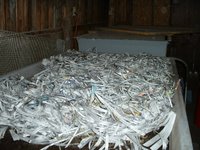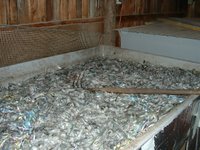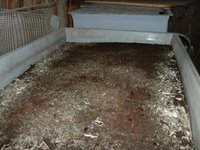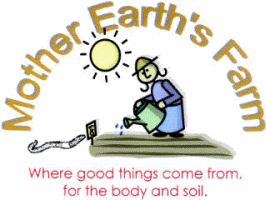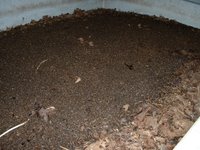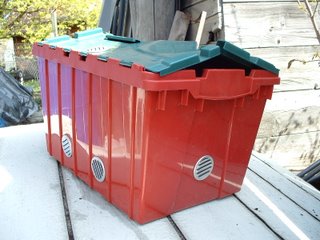
This picture, taken the beginning of November, is the fresh pile of leaves (mostly maple) my neighbor has left for me after fall clean-up in his yard. The pile is probably about 4 feet high and about 6 feet by 10 feet for the biggest part. This is an on-going leaf pile I use for the worm bin. Even in the dead of winter I can dig into the middle of this pile and find workable material to put on my bins which not only provide a layer of breathable material, but act as a blanket on the worm bins holding in heat.
 The handful of bedding to the right was the consistency of the lower layers in the bin at this same time, the beginning of November. It is important that while the weather is still mild, that the bins are turned to get air down into the bedding. Too much moisture and not enough air causes the environment to go anaerobic. This you can tell by the smell of the bedding. It will start to "stink."
The handful of bedding to the right was the consistency of the lower layers in the bin at this same time, the beginning of November. It is important that while the weather is still mild, that the bins are turned to get air down into the bedding. Too much moisture and not enough air causes the environment to go anaerobic. This you can tell by the smell of the bedding. It will start to "stink."
Right now the outside temperature is freezing. Our high today was in the mid 30's and our low was in the low 20's. The leaf pile was frozen on the outer layer, but once I broke through that layer I was able to gather soft wet leaves from inside the pile for the worm bins. The worm bins were reading 56 degrees, with one of them reading 61 degrees. This was the bin I worked last time and added some food waste to, covering with a layer of leaves.
I have one bin which has no heat source. It has been without a heat source since the fall of 2005. So this is the second winter without heat. This has been my best performing bin.
The top layer is frosty looking, but when I inserted a compost thermometer it slid into the bedding material easily, indicating the bedding was not frozen. However, it was reading in the 30's. I did not disturb this bin at all. In the spring I will show you pictures of the worms in this bin. They have consistently out-sized the worms in my other three bins which have a heat source.
I don't work the worms as much during the winter for obvious reasons, it's cold outside... So I try to keep the beds cooler so the worms require less - less food, less water.
Hope your happy worming wherever you are.

 The Soil Food Web: Eat and be eaten.
The Soil Food Web: Eat and be eaten.

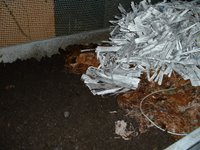
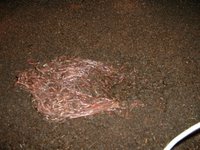
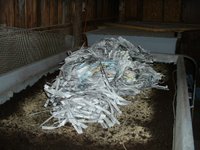 Here I have added shredded newspaper to the bin. I have been using manure all summer because it has been so hot and the manure was well composted. This meant that the bedding wouldn't add to the heat already building up in the bin. But now the bins are starting to cool down, back into the 70's and a nice layer of shredded newspaper is an appreciated change for the worms. They move into it
Here I have added shredded newspaper to the bin. I have been using manure all summer because it has been so hot and the manure was well composted. This meant that the bedding wouldn't add to the heat already building up in the bin. But now the bins are starting to cool down, back into the 70's and a nice layer of shredded newspaper is an appreciated change for the worms. They move into it